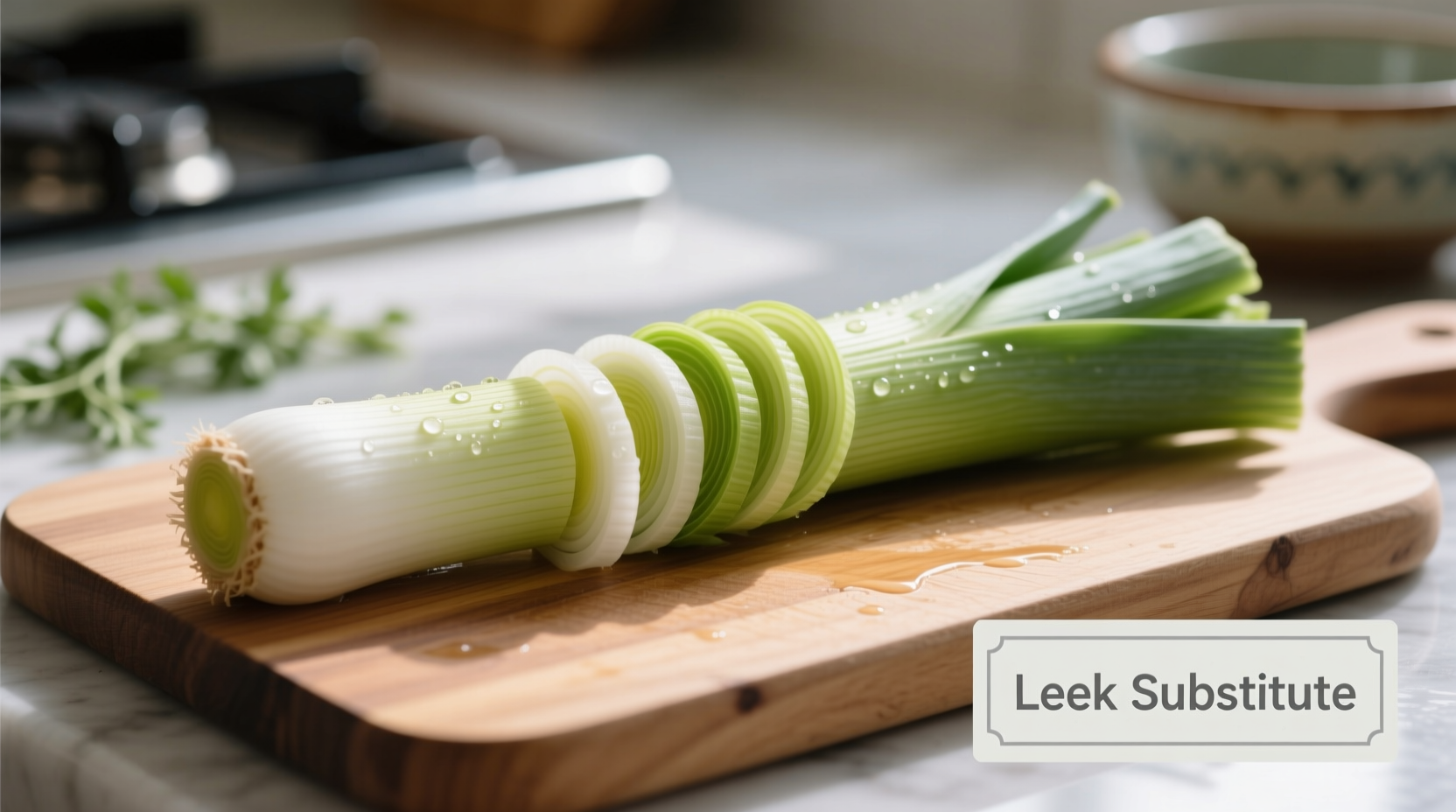When you reach for leeks only to find your pantry empty, knowing the right replacement can save your recipe from disappointment. Leeks offer a unique combination of mild onion flavor with subtle sweetness and a distinctive texture that behaves differently in various cooking methods. This guide provides professional-tested alternatives that maintain your dish's integrity whether you're preparing a delicate vinaigrette or a hearty stew.
Why Leek Substitution Requires Strategy
Leeks aren't just mild onions—they have specific characteristics that affect substitution choices. Unlike regular onions, leeks contain less sulfur compounds, resulting in a more delicate flavor that doesn't overpower dishes. Their layered structure also creates a different mouthfeel when cooked. According to culinary research from the US Department of Agriculture, leeks contain approximately 30% less pungent compounds than yellow onions, explaining their milder profile.

Choosing the Right Substitute by Cooking Context
Professional chefs select leek alternatives based on cooking method rather than using a one-size-fits-all approach. Understanding these contexts prevents common substitution mistakes that can ruin your dish.
For Raw Applications: Salads and Garnishes
When using leeks raw, their crisp texture and mild flavor shine. The best substitutes here maintain similar crunch without overwhelming pungency:
- Scallions (green onions): Use only the white and light green parts. They provide similar texture with slightly more bite. Ratio: 1 leek = 3-4 scallions
- Fennel bulb: Offers comparable crunch with a subtle anise note that complements salads. Ratio: 1 leek = ¾ cup thinly sliced fennel
- Shallots: Milder than onions but stronger than leeks. Soak in cold water for 10 minutes to reduce sharpness. Ratio: 1 leek = ½ medium shallot
For Quick-Cooking Dishes: Stir-fries and Omelets
In fast-cooking applications, substitutes must withstand brief heat exposure without disintegrating:
- Shallots: Their delicate structure holds up well to quick cooking. Chop finely to match leek texture. Ratio: 1 leek = 1 small shallot
- Yellow onion (white part only): Use just the white portion for milder flavor. Ratio: 1 leek = ¼ cup chopped onion
- Asparagus (white variety): Provides similar texture when sliced thin. Ratio: 1 leek = 4-5 asparagus spears
For Long-Simmered Dishes: Soups and Stews
When recipes require extended cooking, substitutes must maintain flavor integrity without becoming bitter:
- Onion and celery combination: 1 part mild onion (Vidalia or Walla Walla) + 1 part celery mimics leek's flavor complexity. Ratio: 1 leek = ¼ cup onion + ¼ cup celery
- Chives (added late): Provides similar onion flavor without overpowering. Add during last 5 minutes of cooking. Ratio: 1 leek = 3 tbsp chopped chives
- Leek powder: Reconstitute 1 tsp powder with 2 tbsp water for concentrated flavor. Ideal when fresh options aren't available.
| Substitute | Flavor Intensity | Best Cooking Method | Substitution Ratio | Preparation Tip |
|---|---|---|---|---|
| Scallions | Mild (7/10) | Raw, quick sauté | 3-4 for 1 leek | Use white/light green parts only |
| Shallots | Moderate (6/10) | All methods | 1 small for 1 leek | Soak in water for raw applications |
| Onion + Celery | Moderate (8/10) | Long-cooking | ¼ cup each for 1 leek | Sweat slowly for best results |
| Fennel | Mild (5/10) | Raw, roasting | ¾ cup for 1 leek | Remove tough core first |
| Chives | Delicate (4/10) | Finishing touch | 3 tbsp for 1 leek | Add at very end of cooking |
Advanced Substitution Techniques
Professional chefs often combine substitutes to recreate leeks' complex profile. For French onion soup, try equal parts shallot and yellow onion with a pinch of sugar to mimic leeks' natural sweetness. When substituting in potato leek soup, use 75% onion and 25% celery with a splash of milk to maintain the creamy texture.
Historical culinary records from Encyclopædia Britannica show that during World War II rationing, British chefs developed the onion-celery combination as a leek alternative that's still preferred by many professional kitchens today. This substitution method preserves both the flavor complexity and textural elements that single-ingredient substitutes often miss.
Avoiding Common Substitution Mistakes
Many home cooks make these critical errors when replacing leeks:
- Using too much onion: Regular onions contain more sulfur compounds, creating overpowering flavor. Stick to the recommended ratios.
- Incorrect timing: Adding substitutes too early in cooking (especially strong options like regular onion) creates bitterness.
- Ignoring texture differences: Leeks maintain structure better than most substitutes. Adjust cooking time accordingly.
- Not adjusting liquid content: Some substitutes release more moisture, requiring slight recipe adjustments.
When substituting in delicate sauces or custards, always start with less substitute than you think you need, then adjust to taste. Remember that leeks' mild flavor serves as a background note in many recipes—the goal is to maintain that subtle presence rather than create a pronounced onion flavor.











 浙公网安备
33010002000092号
浙公网安备
33010002000092号 浙B2-20120091-4
浙B2-20120091-4